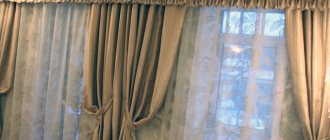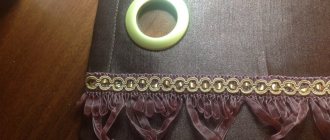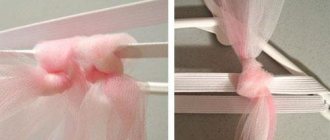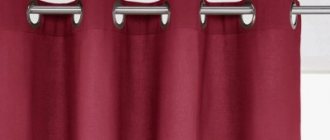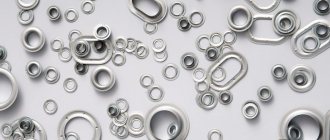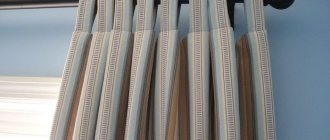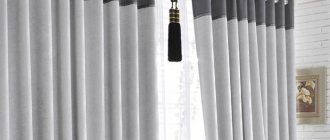Today there are many options for ready-made curtains and tulle. But sometimes windows have non-standard sizes and configurations. Or the design of the finished textile does not match the interior. It happens that the family budget does not allow you to buy expensive curtains with multi-layer draperies. For all these cases, there is one universal solution - individual tailoring. Doing the assembly yourself is not as difficult as it seems at first glance. But at the same time, you need to know how to correctly calculate the tulle and curtains for the window.
When calculating the width of the tulle, not only the length of the cornice is taken into account, but also the characteristics of the fabric
Window decoration with tulle: types of assembly
Folded tulle looks elegant and airy. Previously, each fold had to be done manually. Nowadays it is very easy to achieve a uniform and beautiful assembly - you need to buy a special tape for curtains.
Curtain tape allows you to neatly distribute folds across the entire width of the curtain
Curtain tape is a strip of fabric with cords running through it. By sewing the ribbon to the fabric and tightening the laces, you can make beautiful folds in the material. It is attached using special textile loops on the tape, which are attached to hooks. Transparent braid is bought for light transparent textures, such as: organza, mesh, in rare cases - crystalline, veil. The opaque tape is dense, on a cotton base, intended for curtains and opaque fabrics.
Transparent curtain tape is suitable for tulle curtains
Important! The opaque braid is made of natural cotton. When washed, it can shrink up to 10-15% of its length. Therefore, you need to take it with a reserve and iron it with an iron in the “Steam” mode before sewing.
Different tape models will help you make different types of assembly on the material.
- Uniform. When the braid cords are pulled together, waves with even “columns” are obtained. Another name is “pencil”.
Simple “pencil” assembly
Tulle lambrequin with puffed gathers
Curtain tape with gathering in the shape of glasses
Bow gathered tulle on curtain tape
This assembly is shaped like crow's feet.
If you plan to select fabric for a particular fold size, you need to know the tulle gathering coefficient. It will help in calculating the footage that will be needed for a particular drapery.
Build factor
The gathering factor (GC) is a value that helps determine how much fabric needs to be gathered across the width. Essentially, this is the allowance for the waves and tails, and it determines how magnificent they will be in the end.
The gathering factor depends on the type of folds formed on the curtain fabric
Before you calculate the width of the tulle for the window, you need to find out what the KS will be. To do this you need to know two quantities:
The width of the footage is calculated using a simple formula:
Amount of fabric = k x curtain rod length
Where k is the assembly (filling) coefficient. For different types of assembly that the braid forms, it will be different:
- Pencil – k = 2.5-3.
- Buffs – k = 1.5 – 2.5.
- “Crow's feet” – k = 2.
- Goblet-shaped, bow-shaped – k = 2.5-3.
Note! The KS must be indicated on the packaging of the curtain tape. Typically the average ratio is 1:2.5. It is suitable for almost any curtain design.
Knowing the CS, all that remains is to calculate the required amount of tissue. If, for example, k = 1.5, and the length of the cornice is 275 cm, then to sew curtains you will need to collect 375 cm (3.75 meters) of fabric (1.5 x 250 cm = 375 cm).
Important. When calculating, it is necessary to add allowances for the side seams. As a rule, add 6 cm, 3 cm for each side seam.
Processing the side cut of the curtain
In our example, to the width of 3.75 m, you also need to add 6 cm for the side seams. The total width of the fabric will be 3 m 81 cm.
How to calculate the distance between eyelets?
To calculate the distance between the eyelets, you need to know the parameters of the curtains, as well as the cross-section of the eyelets themselves. The cross-section of the ring is taken as the value of the internal diameter, not the external one, since these two figures will differ significantly.
After calculating these values, you can proceed directly to calculating the frequency of product placement.
- In order to calculate the number of rings, you need to multiply the width of the curtain by 6.
- The remaining side material should be 6 cm (3 cm on both sides).
- Calculation of the remaining footage from the starting to the final hole. It is calculated as follows: the value of the residual material on the side is subtracted from the width of the curtain.
- Calculation of the footage on the fabric in the places where the holes will be located. Formula: the internal section of the ring is multiplied by the number of fittings.
- Calculate the total distance at the center of the holes. Formula: from the value of the remaining footage from the start to the final hole, the footage on the fabric in the places where the holes will be located is subtracted.
- Calculation of the gap in the center of the holes. Calculation formula: one is subtracted from the number of eyelets.
- Calculation of the distance between eyelets. Formula: the value of the yardage on the fabric in the places where the holes will be located must be divided by the number of intervals between units. The resulting value is considered the distance between the eyelets.
How many meters of tulle do you need for a three meter window?
Housewives are often concerned about this very question. The popularity of the dilemma is easy to explain - this width is the most common and is considered standard. In this case, the width can be different: from 4.5 m to 9 m. Naturally, in the first case the material will fall in a small, uniform wave, in the second - in chic, lush coattails.
Important! The window width is measured not by the frame or opening, but by the length of the cornice. This does not take into account decorative elements, such as knobs on the sides of the bar.
On the cornice, it is necessary to measure exactly the part along which the hooks will go - the working length of the cornice
As a rule, if the cornice is 3 meters, then how much tulle you need to take depends on the type of assembly chosen. If the length of the rod is 3 meters, then the calculation is done using the same formula given above. First you need to decide what kind of braid will be used. Accordingly, then the KS will be known, which will be needed to calculate the width of the material for sewing curtains.
Plastic hooks for curtain tape are:
With clasps
The most convenient type of hook for curtain tape in terms of functionality. You put hooks on the curtain tape, fasten them, thereby fixing them on the product.
Hooks for curtain tape
Designer's advice:
- With such hooks for curtain tape, installation and even washing are easier. Hooks can now be put on curtain tape while sitting on the sofa, and not hanging;
- The product can be washed together with the hooks;
- Don't forget to fasten the hook!
Without fasteners
These hooks are less convenient to use, but are also functional. These are mainly Y-shaped hooks. The scheme is the same. We put it on by hand and push it onto the ledge.
Hooks for curtain tape
Calculation of tulle along the cornice: degree of filling
To calculate the material according to the length of the cornice, you need to know what filling is. This is one of the most important criteria in the calculation. It depends on how magnificent the curtains will look in the end. There are three types of filling:
- Small. Minimum acceptable level. Designers recommend using no less than 1:1.5 material. That is, with a window width of 3 m, the minimum amount of fabric for sewing is 3 m x 1.5 = 4.5 m. If you take a smaller amount of organza or veil, the appearance of the product will be more than modest.
Tulle with gather ratio 1:1.5
Tulle with gather ratio 1:2
Tulle with gather ratio 1:3
There are several other nuances that may affect the calculations:
- Density. The denser the material, the less filling should be. Otherwise, little light will enter the room. And, conversely, the thinner and more transparent the texture, the greater the filling you need to choose.
Tulle can be so dense that it can greatly block sunlight
A large pattern on tulle looks beautiful in itself; there is no need to hide it in folds
Advantages of grommet curtains
Having curtains attached to a grommet actually has distinct advantages considering their valuable future appearance. The ease and noiselessness of moving the curtains along the eaves will not leave anyone indifferent. A simple mechanism will ensure that the fabric never gets tangled, stuck or sagging. In addition, in order to form beautiful symmetrical fabric folds, you will not need to adjust the fabric with your own hands. Plastic rings protect the fabric from unwanted deformations. It is also positive to admit that with such curtains it will never be difficult to wash them, since removing and hanging the curtains with eyelets on the curtain rod is much easier than manipulating inconvenient hooks and eyelets.
Selecting curtain sizes
Now you need to determine how to choose the right size of curtains and tulle. That is, find out what the dimensions of the curtains should be for a certain width of translucent curtains. The curtain curtain has a denser structure. Therefore, the KS will be less than for light veils and will be k = 1.5-2.
The higher the gathering factor, the more magnificent the folds on the curtains will be.
Let's calculate the required amount of material for thick curtains, which do not drape well due to their rough texture.
The length of the cornice is 3 m.
Amount of curtain material: 300 cm x 1.5 = 450 cm + 6 cm (allowances) = 456 cm or 4 meters 56 cm.
As a result, you will get drapery as in the photo
If the texture is a little softer, lighter, and allows you to create a beautiful drapery, then the KS can be chosen more - k=2. Then the calculation will look like this:
The length of the cornice is 3 m.
Amount of curtain material: 300 cm x 2 = 600 cm + 6 cm (allowances) = 606 cm or 6 meters 6 cm.
The photo shows curtains with a drapery ratio of 1:2
How to sew curtains with eyelets with your own hands
Step-by-step instructions and a master class, as well as photos, will help you avoid mistakes and disappointments when making such curtains.
1) When calculating the width of the fabric, you need to add an additional margin for processing the side seams (on both sides) of 2x2 cm.
2) For the hem of the bottom - from 7 to 10 cm.
3) Top allowance: width of the eyelet tape + 2 cm. If it is a dense material, then on average 12.5 cm is left for the fold.
4) Curtains always have an even number of eyelets. This is due to the fact that with an odd number of folds, they do not look very attractive.
Let's calculate the size of the curtains based on the standard indicators of an ordinary apartment. If, when measuring in your apartment, you get different data, you can always adjust the numbers based on this example.
Thus, the height of the curtains will be equal to: length from the top edge of the curtain rod to the floor - 254 cm + 4 cm (this is the top of the curtains above the curtain rod) - 1.5 cm (we reduce the length, since the curtain should not touch the floor) and we get 256.5 cm. We increase this figure by the upper and lower allowances 256.5 + 12.5 + 10 = 279 cm.
We cut the fabric according to the calculated length. We ended up with two identical canvases that need to be folded at the bottom by 10 cm. To facilitate the processing process, we use an iron.
First, measure 10 cm from the edge and iron it with an iron. Fold the fold twice more, inward.
We do the upper bend as follows. Iron the edge inside out, 2 cm, and then the remaining 10.5. This way, all allowances will remain inside the hem.
We take the grommet tape and, bending the top edge of the curtains, place it on the fabric, 4 cm away from the edges, cover it with a large fold and iron it so that it sticks to both sides of the fabric.
In the same way, you can iron the side allowances, first 4 cm, and then bend them in half inward. When ready, all hems should be secured with pins and then carefully sewn on a machine.
The last stage of our work is calculating the number of eyelets and installing them.
To calculate the width of the canvas, divide by 20 and add 1; if the number is odd, add another 1.
For example, with a curtain width of 180 cm, dividing by 20 results in the number 9 (odd), so we add 1 and in the end it turns out that we need 10 eyelets.
Let's start the installation. According to the rules, eyelets are installed at a distance of no more than four centimeters from the edge. Attach and trace them along the inner contour, cutting them 2 mm wider than the outlined circle. The distance from the top of the curtain to the middle of the grommet hole is, on average, 3 cm.
The grommet consists of 2 halves, take the one with the protrusion, combine it with the hole, cover the second one with the spikes and snap it into place.
We measure the distance between the outer eyelets and calculate at what intervals to install the remaining ones.
That's all! We create whatever we want with our own hands!
Examples of different collection ratios
In addition to the tape, there are several other options for designing window textiles when sewing. When choosing one of them, it is also important to consider the CS.
- On the eyelets. The fabric sheet is strung on a bar using special metal or plastic rings installed along the upper edge. This option is often used for draping balcony windows. Curtains on the eyelets do not interfere with opening the door, since they can be easily moved to the side with one movement. For curtains with grommets, it is better to choose k=2.
Eyelets on thin tulle are secured using thick curtain tape
Tulle curtain with double ruffle hinges
Before you put fabric on window curtains, curtains or drapes, you need to decide on the fill factor, type of braid, textile design features and accurately measure the length of the cornice. Knowing these parameters, sewing beautiful window textiles will not be difficult. Examples of photos of window curtains with different frames will help you choose the right option that the whole family will like.
Tulle on eyelets will be one of the non-standard solutions when decorating the interior of a room. You can hang curtains on grommets in the kitchen, living room and even bedroom. But what is the principle of creating such devices?
Eyelets are very often used for avant-garde curtain projects and go perfectly with metal curtain rods in techno or hi-tech style.
It may seem that installing such devices is a complex operation that can only be carried out with special equipment, but this is not so. Eyelets are rings that are located at the top of a curtain or curtain. You can install them yourself. The main thing is to follow the rules that will be written below and prepare everything you need.
Types and materials
Today, several types of curtain rings are available.
- With small rings.
This category of eyelets is installed on the cornice using special hooks. - With big rings.
Such product options greatly simplify the process of attaching curtains. They are installed on the curtain rod.
The material used to make curtain eyelets is usually wood, metal or plastic.
Most often, heavy and dense fabrics are chosen for windows, so the eyelets should be made in the form of metal rings - they can withstand heavy material and give an aesthetic appearance to the curtains. For lighter curtains and tulles, you can choose plastic eyelets. They have a low price and excellent resistance to corrosion compared to metal options. In the case of tulle, metal eyelets are not suitable, since metal can damage the delicate material.
To create an interior in ethnic or country style, wooden models are an excellent solution. The environmentally friendly material will appeal to people who value such quality in a product. The material from which the cornice is made also plays an important role, since it is threaded into the rings. Curtain rods made of wood, metal and plastic are also used here.
Rings have a variety of shapes. Thanks to modern technologies, products of square, triangular and other geometric shapes are produced.
Preparation and production
First of all, you need to make the side seams, then iron 1 cm over the fabric on the wrong side. After this, cut out the adhesive fabric. It is glued not to the front side, but to the back. Stepping back a little from the processing bend, we begin gluing.
The width of the adhesive fabric should be commensurate with the diameter of the rings. It will be necessary to leave a certain number of centimeters from the top so that the grommet does not overlap the seam that will be laid. There are several types of adhesive fabric; it may require exposure not only to temperature, but also to steam.
Fabric calculation
Fabric calculation diagram for curtains
The calculation scheme for curtain rings is very simple. The first step is to find out the diameter of the eyelet itself, most often it is 5.5 cm. The number of rings, as you know, must be even.
Let's say we have a finished curtain 1.55 m long, we need to subtract the length that is not useful in the calculation (3 cm on one side and 3 cm on the other before installing the rings + 5.5 cm, the diameter of one eyelet). These readings are subtracted in advance. Divide the remaining amount by 20.5 cm (15 cm distance between eyelets + 5.5 cm).
We get the number of distances between the eyelets, but since 1 ring was included in the calculation, its size was subtracted, we have 8 eyelets. The quantity is even and it fits the bill.
3 cm, which are subtracted on the sides, is the distance from the edge along with the side seam to the outer eyelet. It makes no sense to subtract a smaller distance, since the ring may end up on the side seam. Now you can calculate the approximate height of the tulle. As you know, when finished it has a large size.
Example. We subtract the amount from the length of the tulle (it is better to retreat from the edge not by 3, but by more than 4 cm, because the tulle is large and nothing bad will happen to it). We calculate according to the same scheme and divide by the distance 20.5, since the true distance is still unknown. As a result: 600-(4+4+5.5)=586.5, again divide 586 by 20.5 and get 29. This result is not satisfactory, because it must be even. Divide 586 by 29, we get 20.2.
For 30 rings, the distance was 20.2 cm. The result was quite the optimal size. The fold will fit perfectly. The main thing is that it is at least 10 cm. This distance is small and is not suitable for installation.
Curtains and curtains get a second life, they become the ideal addition to any interior.
Tulle eyelets go well with most styles. Thanks to these devices you can achieve an unsurpassed effect of a beautiful wave.
Curtains with eyelets are a rather difficult interior element to create. The difficulty lies not only in installing accessories on the sewing material, but also in the need to make calculations. In fact, the distance between the eyelets can be calculated based on already existing formulas. They were created largely experimentally, however, the considerable experience of professional seamstresses can be trusted. This article will describe the algorithm for calculating the interval in the middle between the elements of the fittings, and also provide a specific example, which allows you to see the real numbers.
How to install it yourself?
To properly install rings on curtains, you must perform the following steps:
- do simple calculations yourself;
- buy curtains;
- purchase rings and, if necessary, grommet tape;
- prepare a workplace - any flat horizontal surface.
After the calculations, it is necessary to prepare the curtains.
- wet the material and leave it to dry a little;
- make a lining if necessary;
- process the seams.
After such procedures, you can insert rings into the curtains.
Sooner or later, any housewife and needlewoman may be faced with the question: how much fabric do you need to buy to sew curtains? How to make the correct calculation and take the correct measurements? Today, curtains with eyelets are especially popular. Such curtains fit well into any interior, be it a kitchen, living room, bedroom, even a bathroom. We will consider step by step the entire scheme of work on calculating fabric for curtains with eyelets. We will need:
- roulette,
- paper,
- pencil pen.
The length of the fabric can be measured in 2 ways.
The first method is to measure the distance from the top edge of the rod to the floor level. The second method, we measure the distance from the bottom edge of the rod to the floor level, and also measure the diameter of the rod and add these 2 values.
It is advisable to take measurements along the edges of the cornice and in the middle, because in our apartments the floors and ceilings are sometimes not perfectly smooth. When we have taken 3 measurements, we select the smallest one. For example, at one point you got 250 cm, at another - 251 cm, and at the third - 250.5 cm, then we choose 250 cm, because this value is the smallest.
Curtains with grommets have a ridge at the top, which is usually 2-4 cm.
That. Calculation of the length of the finished curtain will look like this: to the distance from the rod to the floor level + 2-4 cm (this is a scallop) - 2 cm (distance from the floor level so that the curtain does not come into contact with the floor). In my case, 250 + 3 - 2 = 251 cm. Although, if someone likes the curtains to go down to the floor and spread over it, then it is necessary not to subtract 2 cm, but add from 10-50 cm, depending from the curtain model.
So, we have calculated the finished length of the curtains, but remember, allowances for processing seams are not taken into account here; more detailed information about processing the bottom and side seams can be found. When processing the top edge of the curtain on the grommets, you need to remember that you need to make an increase in fabric equal to double the width of the grommet tape.
Curtains with eyelets can be made with a cuff; see how to sew such curtains. Now let's decide on the width of the curtains. Why do we measure the working surface of the cornice? and now, just remember 2 rules:
- minimum tulle width = length of the working surface of the cornice x 2,
- minimum width of the curtain = length of the working surface of the cornice x1.5.
Who loves the splendor of folds, then it is necessary to increase the coefficient.
Also, don’t forget about processing the side seams. When calculating the width of curtains with eyelets, you need to decide on the number of eyelets and their location. I make sure that the number of eyelets is even, then the edges of the curtain are directed in one direction; if the number of eyelets is odd, then the edges of the curtain are directed in different directions. It is also necessary to remember the principle of the location of the eyelets, the distance between the eyelets should be in the range from 15 to 22 cm. From the processed edges, the first and last eyelet are located at a distance of 5-7 cm from the edge, see below. After you have multiplied the working width of the cornice by a factor of 1.5, draw a diagram of the location of the eyelets; you may need to add a little width or decrease it a little. I hope the principle of calculation is clear and you can now independently calculate the desired and required amount of fabric for curtains on eyelets. Do you want to be the first to receive my articles on health and beauty? Subscribe to my blog.
You can use site materials only with an active link.
I really like the grommet curtains. They look great in both the living room and bedroom.
1. What types of eyelets are there and which ones are better to choose?
Eyelets differ: according to the material from which they are made (metal or plastic); in shape (round, curly); by color (transparent, plain colors, imitating the color of metal, wood, leather and other materials); according to the diameter of the internal hole (from 10.5 to 50 mm). You need to choose eyelets depending on the curtain model you want to get as a result and the cornice on which it will be attached. Most often, round eyelets are installed to match the cornice, furniture fittings or curtain material. But if you want to focus on the eyelets themselves as a decorative element of the curtain, you can use curly eyelets. For example, grommets in the shape of a steering wheel or a dolphin for children's curtains in a marine style. The diameter of the grommet hole should be 1.5 cm larger than the diameter of the rod (pipe) of the cornice. Otherwise, the curtain will not move well along the cornice, because the eyelets will get stuck on the rod. As for the choice of grommet material, it is more practical to use plastic ones. They do not damage the curtain rod, move quietly along the curtain rod, and there is no risk that during washing the metal will oxidize and stain the curtain fabric with rust. Plastic eyelets can generally be removed for washing and then put back. In addition, plastic eyelets are cheaper than metal ones and do not require a special press to install them.
3. How many eyelets are needed.
When calculating the number of eyelets required for a curtain, we proceed from the following:
Calculation of the number of eyelets
A) The number of eyelets on the curtain must be even (that is, 8, 10, 12, 16, and so on). This is necessary so that both side edges of the curtain are directed towards the window. If you install an odd number of eyelets, one edge will be directed towards the room. It doesn't look nice.
B) The optimal distance between the centers of the eyelets is 18 cm. If you don’t get exactly 18, don’t worry. You can do a little more or a little less. The main thing is that the distance between the centers of the eyelets is not more than 22 cm or less than 15 cm. Then the folds will be beautiful and even.
Location of eyelets
C) From the side edge of the curtain to the center of the first grommet, the distance is 5 - 7 cm. This distance depends on how wide the side edge hem is and on the diameter of the grommet. You need to make it enough so that the eyelet does not get on the side hem. Otherwise, it will not close because the fabric is too thick. You should not make a very large distance, otherwise the free end of the curtain will bend unsightly.
Let's calculate the number of eyelets:
1) n1 = (L - 2a) : 18 + 1, where n1 is the estimated number of eyelets,
L is the width of the finished curtain on which the eyelets will be installed, in centimeters,
A is the distance from the side edge of the curtain to the center of the first eyelet, in centimeters.
2) n2 is the even number closest to n1, that is, the very number of eyelets that we want to know.
Eyelet diameters
Example: Your curtain is 2 meters wide (that is, 200 cm). The eyelets you will install have a hole diameter (inner diameter) of 45mm (4.5cm) and an outer diameter of 75mm (7.5cm). You want to make the hem of the side edge 2.2 cm.
Then the distance from the side edge of the curtain to the center of the first eyelet you need to take is: the width of the side hem + half the outer diameter of the eyelet + the indentation from the hem: 2.2 cm + 7.5 cm: 2 + 0.3 = 6.25 cm.
Thus, L = 200 cm, a = 6.3 cm. We calculate the number of eyelets: n1 = (200 cm - 2 x 6.3 cm): 18 cm + 1 = 11.4 pcs. But we need an even number of eyelets, so we round n1 to 12 or 10. Moreover, if we take 10 eyelets, then the distance between their centers will be: b = (200 cm - 2 x 6.3 cm) : (10 - 1 ) = 20.82 cm, and if we take 12 eyelets, then the distance between the centers of the eyelet holes will be: b = (200 cm - 2 x 6.3 cm): (12 - 1) = 17.04 cm. What is the best distance to make , you decide. But keep in mind that the greater the distance between the eyelets, the larger the folds. So proceed from what type of curtains suits you best. By the way, if you have two curtains, do not forget to multiply n2 by 2. 4. What is needed to install eyelets.
In addition to the eyelets themselves, you will need duplicating material to strengthen the top of the curtain. It is necessary to strengthen the curtain fabric, otherwise the grommet will not hold due to the displacement of the material. In addition, the reinforced top of the curtain drapes more beautifully, and the folds are clearer.
Grommet tape
The most convenient way to do this is to use a special grommet tape, which is a ready-made strip of hot-melt adhesive material. Grommet tape is produced in different widths: 5, 7, 10 and 12 cm. Choose a tape of a width that will be larger than the outer diameter of the grommet plus 2 cm. For example, if you install grommets with an outer diameter of 7.5 cm, then grommet tape will suit you 10 and 12 cm. And if you want to put small eyelets, with an outer diameter of 3.6 cm, then you can use 7 cm eyelet tape. Transparent eyelet tape is available for transparent fabrics.
To strengthen the top of the curtain under the eyelets, you can also use thick duplerin, but this is less convenient, since it will have to be cut, and due to the need to join the strips, the top will be less neat. If you still decide to use doublerin, place the joints of the strips of adhesive material between the places where the eyelets are installed, where the curtain will bend towards the wall. This will avoid excessive thickness of the fabric, due to which the eyelet may not close, and hide the joint. You will also need an iron for gluing the grommet tape or dublerin, a measuring tape and a pencil or marker for marking, scissors or a punch for cutting holes for the grommets.
5. How to prepare a curtain for installing eyelets.
Eyelets are installed on a completely finished curtain. That is, all edges must be processed. If the curtain is lined, it must also be sewn on.
The top of the curtain must be doubled with grommet tape or doubler tape.
The drapery coefficient of curtains on eyelets is 2 - 2.5. Otherwise they look ugly. That is, in order for the finished draped curtain on the eaves to occupy 1 meter, when unfolded it should have a width of 2 - 2.5 meters. Take this into account when calculating the required amount of fabric.
There are two main ways to finish the top of eyelet curtains.
In the first case, the curtain fabric is a single whole. In the second, the upper part of the curtain is trimmed with a different type of fabric.
Combining fabrics in eyelet curtains is used for both aesthetic and practical reasons. For example, if the curtain on which you are going to install grommets is made of light material (tulle, veil, organza, mesh), then it will be quite difficult to carefully process the top edge. This is due to the mobility of the fibers of these tissues and their transparency.
Top of curtains with eyelets with contrasting trim The second common reason for finishing the top of curtains with eyelets with another type of fabric is the insufficient height of the curtain material. For example, if the height to the top of the rod of your curtain rod is 250 cm, then the height of the curtain material should be: 250 cm - 1-2 cm (distance from the floor to the bottom edge of the curtain) + 250 * 0.02 (for shrinkage) + 2-5 cm (curtain comb) + 20-24 cm (double hem of the top) + 4-15 cm (bottom processing) = 279-298 cm. And the height of curtain fabrics is most often 280 cm.
Curtain comb on eyelets
1. Decorate the material of the future curtain. To do this, the fabric must be wetted, dried until damp and gently ironed. This is done so that the curtain material shrinks before cutting and sewing, and not after the first wash, and the finished curtains do not unexpectedly become 5 cm shorter. This is especially important for natural fabrics: cotton, linen, wool, silk. Some synthetic fabrics do not shrink, but decatening is still worth doing because, as a rule, it is not known in advance whether the material will shrink and how much. After decaling, measure the height of the material again.
2. Decide what kind of hem and what kind of comb you want to make and calculate what height of material is required for your product. If after decorating you have enough fabric, you can start sewing curtains with eyelets made from solid fabric. If there is not enough, you will have to combine the curtain fabric.
The sequence of sewing curtains on eyelets is as follows: ironing the top of curtains on eyelets
Processing the top of the curtain on the eyelets.
1) Measure 2 times the width of the eyelet tape from the top edge (the edge of the fabric is not taken into account, it must be carefully cut off). Fold to the wrong side and iron.
2) Place the grommet tape into the fold, with the edge toward the fold of the fabric, departing from the side edge the width of the hem. Fold the fabric back over the grommet tape and iron it gently.
Processing the top of curtains on eyelets
Glue in small sections, as long as the iron platform can handle: level the section, place the iron, apply pressure, wait until it sticks and move on to the next section. There is no need to move the iron over the area to be glued, because the fabric may shift and stick unevenly.
You need to glue the tape so that the hot melt adhesive melts, but does not seep through the curtain fabric to the outside. Therefore, you need to know how long and with what pressure to hold the iron on the treated area. To find out for sure, you need to experiment before you start processing the top of the curtain. Buy fabric and grommet tape with a small supply and practice. A small overpayment is compensated by the absence of the risk of damaging a large product.
To avoid burning the curtain material, use an ironing iron (a thin cotton or linen material that is placed between the fabric being ironed and the iron during ironing).
Processing the top of curtains on eyelets with machine stitching
3) When you have glued almost the entire top of the curtain and reached the second side edge, cut off the rest of the grommet tape, departing from the edge the width of the side hem.
4) Secure the top flap with a machine stitch, departing 1-2 mm from the edge of the fold.
Processing the sides and bottom of the curtains with eyelets.
In general, the processing of the lower and side edges of the curtains with grommets does not differ from similar processing of other types of curtains. There are various methods; the choice of one or another processing method depends on the type of fabric, your wishes for the appearance of the curtains and the level of your skill. We will talk about how the sides and bottom of curtains are processed in the following articles.
6. Mark the holes for the eyelets on the curtain.
1) Lay out the finished curtain on a flat surface. All measurements and markings must be made when the curtain is ironed and lies flat.
2) Mark the position of the outer eyelets. To do this, take the grommet and place it at the desired distance from the top and side edges of the curtain. Make sure that it does not go over the seams, otherwise the eyelet may not close due to the fabric being too thick. Make a dot exactly in the center of the grommet hole with a pencil or fabric marker. Do the same for the other side of the curtain. Please note: the distance that you stepped back from the top for the first eyelet must be maintained for all other eyelets so that all holes are at the same level.
3) Calculate the distance between the centers of the eyelets. To do this, measure the distance between the centers of the marked outer eyelets and divide it by the number of eyelets, reduced by 1. For example, if you get a distance of 187.4 cm, and the number of eyelets is 12, then the distance between their centers will be: 187.4: (12 -1) = 17 cm. 4) Mark the centers of all remaining eyelets, making dots with a simple pencil or fabric marker. 5) Mark the holes for the eyelets. To do this, you need to take the grommet and, placing it on the center marking, circle the inner hole. The previously marked point should be located exactly in the center of the grommet hole. 7. Cut out the holes. It is most convenient to cut out the grommet holes with a special punch. But you can also use regular scissors. You need to cut holes for the eyelets, retreating 1-1.5 mm from the markings. This is necessary so that the edge of the hole is completely hidden inside the grommet. You should not make a larger hole, otherwise the grommet will not hold firmly enough. Try to cut the holes carefully so that the edge does not fray or crumble. The holes in all layers of fabric should be the same. 8. Install the eyelets. Place the eyelet halves on the front and back sides of the curtain. Make sure they are level and press until they click. No special equipment is required to install plastic eyelets; they are installed manually.
Sooner or later, any housewife and needlewoman may be faced with the question: how much fabric do you need to buy to sew curtains? How to make the correct calculation and take the correct measurements? Today, curtains with eyelets are especially popular. Such curtains fit well into any interior, be it a kitchen, living room, bedroom, even a bathroom. We will consider step by step the entire scheme of work on calculating fabric for curtains with eyelets. We will need:
- roulette,
- paper,
- pencil pen.
The length of the fabric can be measured in 2 ways.
The first method is to measure the distance from the top edge of the rod to the floor level. The second method, we measure the distance from the bottom edge of the rod to the floor level, and also measure the diameter of the rod and add these 2 values.
It is advisable to take measurements along the edges of the cornice and in the middle, because in our apartments the floors and ceilings are sometimes not perfectly smooth. When we have taken 3 measurements, we select the smallest one. For example, at one point you got 250 cm, at another - 251 cm, and at the third - 250.5 cm, then we choose 250 cm, because this value is the smallest.
Curtains with grommets have a ridge at the top, which is usually 2-4 cm.
That. Calculation of the length of the finished curtain will look like this: to the distance from the rod to the floor level + 2-4 cm (this is a scallop) - 2 cm (distance from the floor level so that the curtain does not come into contact with the floor). In my case, 250 + 3 - 2 = 251 cm. Although, if someone likes the curtains to go down to the floor and spread over it, then it is necessary not to subtract 2 cm, but add from 10-50 cm, depending from the curtain model.
So, we have calculated the finished length of the curtains, but remember, allowances for processing seams are not taken into account here; more detailed information about processing the bottom and side seams can be found. When processing the top edge of the curtain on the grommets, you need to remember that you need to make an increase in fabric equal to double the width of the grommet tape.
Curtains with eyelets can be made with a cuff; see how to sew such curtains. Now let's decide on the width of the curtains. Why do we measure the working surface of the cornice? and now, just remember 2 rules:
- minimum tulle width = length of the working surface of the cornice x 2,
- minimum width of the curtain = length of the working surface of the cornice x1.5.
Who loves the splendor of folds, then it is necessary to increase the coefficient.
Also, don’t forget about processing the side seams. When calculating the width of curtains with eyelets, you need to decide on the number of eyelets and their location. I make sure that the number of eyelets is even, then the edges of the curtain are directed in one direction; if the number of eyelets is odd, then the edges of the curtain are directed in different directions. It is also necessary to remember the principle of the location of the eyelets, the distance between the eyelets should be in the range from 15 to 22 cm. From the processed edges, the first and last eyelet are located at a distance of 5-7 cm from the edge, see below. After you have multiplied the working width of the cornice by a factor of 1.5, draw a diagram of the location of the eyelets; you may need to add a little width or decrease it a little. I hope the principle of calculation is clear and you can now independently calculate the desired and required amount of fabric for curtains on eyelets. Do you want to be the first to receive my articles on health and beauty? Subscribe to my blog.
You can use site materials only with an active link.
Every woman’s dream is to make her home, apartment or just a room beautiful and cozy. This task can be easily accomplished by sewing curtains with eyelets.
What needs to be changed in the interior to feel calm and happy at home? Look at the windows of your apartment, do you like how they are decorated, do the color and shape of the curtains suit the decor?
If you are not very happy with what you see, let's create a new, sophisticated interior together. Let's start doing this by changing the curtains. There is no need to be afraid, everything will work out. As they say, it is not the gods who burn the pots.
General rules
When making calculations, you should remember one of the basic rules for sewing such curtains: the number of eyelets must be even. Why? Because it is precisely thanks to the even number that the side sections of the fabric will be positioned in such a way that they will not be visible from the room, that is, they will be turned towards the window.
If there is an odd number of them, the side sections will look into the room, and this will have a very negative impact on the appearance of the curtain and the design of the room.
When carrying out the calculation, you should also take into account that the optimal number of holes per 1 meter of width is the number 6. This means that to obtain the result you simply need to multiply the width of the panel in meters by 6. The resulting result will indicate the number of round metal rings that are needed to sew this interior element.
It should also be remembered that on average the distance between the holes in the fabric should be from 10 to 15 cm. It is partly determined by the diameter of the selected fittings. For optimal movement of the curtain on the rod, it is recommended to make an indent of 3 cm from the outer hole to the edge.
This value remains the same regardless of the width of the curtain.
Formulas and sequence of calculus
If you have the appropriate data, you can start calculating using the formulas below. What data is needed to make calculations:
- internal diameter of 1 unit of fittings;
- curtain width.
Sequence of calculation operations:
- How many round metal rings do you need? Calculated using the formula: curtain width in meters * 6.
- Calculating the remaining centimeters of fabric on the sides: 3 cm X 2 sides = 6 cm.
- Calculation of the remaining footage from the first to the last hole. It is calculated by the formula: the width of the curtain is the remainder of the centimeters on the sides (i.e. 6 cm).
- Calculation of the footage on the canvas that the holes occupy. It is calculated by the formula: internal diameter of fittings * by their number (pcs.).
- Counting the total gap in the middle of the holes. It is calculated by the formula: the remainder of the material from the first to the last ring is the distance on the canvas that the metal rings occupy.
- Counting the interval in the middle of the holes. Calculated by the formula: number of round metal rings – 1.
- Calculation of the gap between units of fittings. Calculate using the formula: calculation of the gap on the canvas that the holes occupy / by the number of intervals between them.
The result obtained is the width of the distance between the fittings.
What you need to install grommets
Eyelets are installed in sewing workshops, but this can be done at home with your own hands. To work you need to prepare:
- Ready ironed curtains.
- Eyelet tape made of hot-melt adhesive material.
- Threads.
- Tape measure.
- Pencil or felt-tip pen for fabric.
- Sharp scissors or a special punch.
- Iron.
Related article: Fabrics for roller blinds: classification and characteristics
Brief installation instructions:
- You need to purchase the required number of rings.
- Mark their location on the canvas.
- Cut with scissors or punch holes according to the markings.
- Place the halves of the plastic eyelet on both sides of the curtain and press until it clicks.
Example
For a simpler explanation of how to calculate everything in practice, an example with specific data will be given below. The initial data, such as the internal diameter of the metal ring and the width of the blade, will be taken as 25 mm and 4 m, respectively.
The procedure for carrying out calculation operations:
- Calculation of the number of round metal rings required: 4 m * 6 = 24.
- Calculation of the remaining centimeters on the sides 3 cm x 2 = 6 cm.
- Calculation of the remaining fabric from the first to the last hole. 4 m (400 cm) – 6 cm equals 3 m 94 cm.
- Calculation of the gap on the canvas, which is occupied by holes: 25 * 24 pcs. = 600.
- Calculating the footage of material in the middle of the holes. 3 m 94 cm (3940) – 600 = 3340.
- Counting the number of gaps in the middle of the holes. 24 – 1 = 23.
- Calculation of the interval between eyelets. 3340 / 23 = 145 or 14.5 cm.
14.5 cm is the width of the distance between the eyelets.
As can be seen from the information presented in this article, in order to calculate everything correctly, you only need a tape measure or a measuring tape, a working calculator (on your phone or on your computer) and compliance with the step-by-step algorithm described above. By the way, as in the case of taking measurements, it is advisable to carry out calculations according to the above algorithm twice. It’s easy to get confused in the variety of numbers, and one wrong result can ruin the entire fabric prepared for sewing.
It is recommended to write down all the results obtained during the calculation process - this will help in marking the processed fabric and will greatly simplify it.
